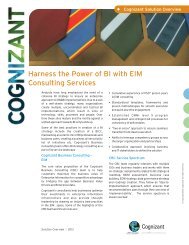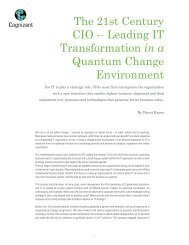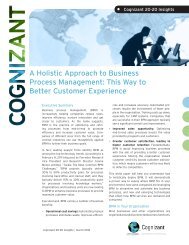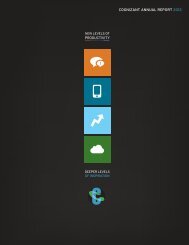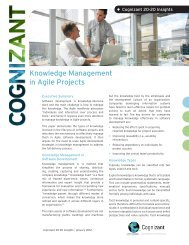DOWNLOAD "Making BYOD Work for Your Organization" - Cognizant
DOWNLOAD "Making BYOD Work for Your Organization" - Cognizant
DOWNLOAD "Making BYOD Work for Your Organization" - Cognizant
You also want an ePaper? Increase the reach of your titles
YUMPU automatically turns print PDFs into web optimized ePapers that Google loves.
Another key element is the cost <strong>BYOD</strong> entails in setting up new infrastructureand ensuring support <strong>for</strong> diverse technologies in a non-standard environment.Organizations should also determine the liability they are willing to assume (seeFigure 5), as well as the tax and legal implications of allowing <strong>BYOD</strong>, especiallywhen reimbursing employee expenses.To support <strong>BYOD</strong>, organizations also need to prepare enterprise applications towork with the allowed set of personal devices, which entails customizing, developingand updating applications to work with personal devices. Support is another criticalaspect, as employees need anytime, anywhere access to either live agents orself-help tools. A mix of sourcing, automation and strong technical customersupport is essential to a robust <strong>BYOD</strong> support model. A successful strategy willensure that IT and the business units agree on how to approach the <strong>BYOD</strong> program.Companies should consider a middle path between the two extremes of thecomplete freedom that employees desire and the full control thatorganizations seek over personal device work usage. A flexible and scalablestrategy will better accommodate the growing demand <strong>for</strong> <strong>BYOD</strong>, given the rapidlyevolving device technology landscape.PolicyImplementing the <strong>BYOD</strong> strategy is only possible with a comprehensive policy.To develop an effective policy, organizations need to define and understand factorssuch as:Which devices and operating systems to support.Security requirements based on employee role and designation.The level of risk they are willing to tolerate.Employee privacy concerns.Employee demand <strong>for</strong> freedom in how they work and use technology hasserious ramifications <strong>for</strong> IT environments. This demand is altering ITdepartments’ traditional structure and scope of control. Understanding this alteredEmployee vs. Company Liability• Better control over devices canbe applied (blocking ofmarketplace applications, etc.)• Better security• Comparatively easier <strong>for</strong>en<strong>for</strong>cing policy andcompliance• Need <strong>for</strong> application licensemanagementCorporateLiable,CappedExpenseIndividualLiable,No/CappedExpenseCorporateLiable,CompleteExpenses PaidIndividualLiable,CompleteExpenses Paid• Reduced IT overhead• Reduced device procurementcost (Cap-Ex)• Better choice of device• Challenges in deployingcorporate applications due tonon-standardization of OS• Better control over expenditure• Reduced device running cost (direct Op-Ex cost)Corporate liable devices are recommended <strong>for</strong> environments with higher data security risks (e.g., financial services);individual liable devices are recommended <strong>for</strong> environments with lower data risks (e.g., education).Source: <strong>Cognizant</strong>Figure 59 FUTURE OF WORK June 2012




